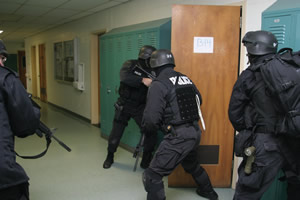Buckets of Rocks and Baseball Bats in Schools
Don't laugh too lightly.

PHOTO © LARRY ST. PIERRE
The last six months have almost been a blur in some ways. Our analysts are working on more than 40 school security assessment projects for more than 750 schools with over 5,000 buildings. We are also providing post-incident assistance for five different planned K-12 school attacks. During a meeting with a district-level team, a school security professional I respect immensely was joking with the team about two school systems in Pennsylvania that have made the news for unsound approaches to active shooter incidents. One school superintendent was castigated in the national news for his decision to place a bucket of rocks in each classroom so students and staff could “stone” an active shooter. Soon after, another district was heavily criticized for the decision to arm teachers with miniature baseball bats to use to disarm a gunman. There was considerable laughter in the room until we mentioned that in a meeting with principals in their district earlier that day, one principal stated that a number of her staff wanted to know what they should do if there was an active shooter in a setting other than a classroom. She related that she had provided her teachers with baseball bats after completing the Run, Hide, Fight approach used in the district. She told us that teachers were concerned that they would not have their baseball bats with them as they moved about the school each day. I hasten to point out that this is not just a good public school system but a high-performing district with a well-earned reputation for highly competent administrators.
The laughter in the room quickly grew uneasy. Everyone knew the chances that a student would attack a staff member or another student with a baseball bat were infinitely higher than the chances that a staff member would be able to stop an active shooter with one. In my experience, it would be extremely difficult for an educator or a school district to defend against litigation relating to an attack of a student or staff member with a district issued baseball bat. Anyone who has ever been involved with an assault with a baseball bat, claw hammer, metal pipe, or crowbar will be forever respectful of the damage these objects can cause. Anyone who does not consider blunt objects to be dangerous weapons should listen to the audio recording of a medical student in Speedway, Ind., as he tries to kill four people with two hammers and a hatchet. In fact, you can hear the skull of one of the victims being shattered to such an extent that 21 staples were needed to patch it.
While this district has in no way shape or form intentionally encouraged teachers to keep baseball bats as weapons in their classrooms, the combination of the Run, Hide, Fight concept and the way that this type of concept is treated in the media and on social media, helps us to understand how these types of disconnects can occur. This is but one of hundreds of alarming examples of how easy it can be for many current options-based active shooter training programs to have extremely dangerous unintended, and in some cases indefensible, consequences. While I have never been against properly taught options including running, seeking cover, and in exceedingly rare instances, fighting an armed aggressor, much of the training we are seeing is not properly structured and is, quite frankly, dangerous as currently taught. Before you make light of the school districts that have implemented such ill-advised measures, it might be a good idea to ask if anyone in your organization could have implemented similarly unsound measures due to the intensive levels of anxiety and outright fear.
In my experience, the many serious injuries, worker’s compensation claims, and litigation relating to poorly implemented active shooter training programs that we are seeing will result in more cautious approaches over time. In the interim, good quality communications, thoughtful training, and effective fidelity testing can help avert the fear-based and increasingly common dangerous conditions we have seen across the nation.
This article originally appeared in the School Planning & Management September 2018 issue of Spaces4Learning.
About the Author
Michael Dorn serves as the executive director for Safe Havens International, Inc., an IRS-approved, nonprofit safety center. He has authored and co-authored more than 20 books on campus safety. He can be reached through the Safe Havens website at www.safehavensinternational.org.